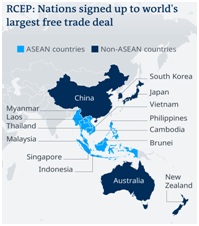Context
The RCEP will come into effect on January 1, 2022, marking the formation of the world’s largest free trade zone in terms of trade volume.
What is RCEP?
- RCEP is a free trade agreement between Asia-Pacific nations of Australia, Brunei, China, Cambodia, Japan, Indonesia, Laos, South Korea, Malaysia, New Zealand, Myanmar, Singapore, Thailand, the Philippines, and Vietnam.
- India and the United States are not members of RCEP.
- The 15-member grouping accounts for 30% of the world’s population and 30% of global GDP (2.2 billion people). Thus, it is the largest trade bloc in history.
- By comparison, the United States-Mexico-Canada trade agreement (USMCA) covers 28% of world trade, while the European Union's Single Market is a distant third at nearly 18%.

Background
- Negotiations on the RCEP deal started in 2012.
- India was also part of the negotiations. However, India pulled out in 2019 because of concerns over lower tariffs.
- Before India, RCEP excluded the USA, which had withdrawn from the Trans-Pacific Partnership (TPP) in 2017.
|
Why is India not a part of RCEP?
- India did not join RCEP raising a concern that this deal would open it up to Chinese goods, and thus increase its trade balance with China.
Objectives of RCEP
- To lower tariffs, open up trade in services and promote investment to help emerging economies catch up with the rest of the world.
- To help reduce costs and time for companies by allowing them to export a product anywhere within the bloc without meeting separate requirements for each country.
- It also touches on intellectual property, but will not cover environmental protections and labour rights.
